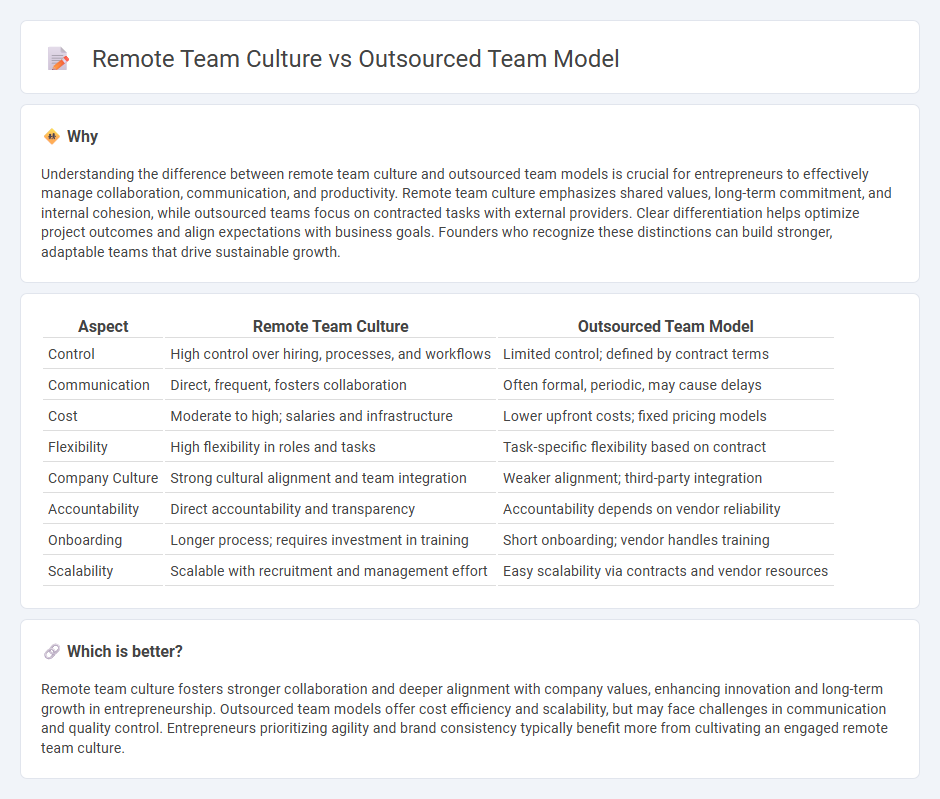
Remote team culture fosters collaboration, accountability, and long-term commitment among geographically dispersed employees, enhancing innovation and consistent performance. In contrast, the outsourced team model typically emphasizes cost efficiency and specialized skills but may face challenges in integration and communication. Explore the advantages and risks of each approach to determine the best fit for your entrepreneurial venture.
Why it is important
Understanding the difference between remote team culture and outsourced team models is crucial for entrepreneurs to effectively manage collaboration, communication, and productivity. Remote team culture emphasizes shared values, long-term commitment, and internal cohesion, while outsourced teams focus on contracted tasks with external providers. Clear differentiation helps optimize project outcomes and align expectations with business goals. Founders who recognize these distinctions can build stronger, adaptable teams that drive sustainable growth.
Comparison Table
| Aspect | Remote Team Culture | Outsourced Team Model |
|---|---|---|
| Control | High control over hiring, processes, and workflows | Limited control; defined by contract terms |
| Communication | Direct, frequent, fosters collaboration | Often formal, periodic, may cause delays |
| Cost | Moderate to high; salaries and infrastructure | Lower upfront costs; fixed pricing models |
| Flexibility | High flexibility in roles and tasks | Task-specific flexibility based on contract |
| Company Culture | Strong cultural alignment and team integration | Weaker alignment; third-party integration |
| Accountability | Direct accountability and transparency | Accountability depends on vendor reliability |
| Onboarding | Longer process; requires investment in training | Short onboarding; vendor handles training |
| Scalability | Scalable with recruitment and management effort | Easy scalability via contracts and vendor resources |
Which is better?
Remote team culture fosters stronger collaboration and deeper alignment with company values, enhancing innovation and long-term growth in entrepreneurship. Outsourced team models offer cost efficiency and scalability, but may face challenges in communication and quality control. Entrepreneurs prioritizing agility and brand consistency typically benefit more from cultivating an engaged remote team culture.
Connection
Remote team culture fosters flexibility, communication, and trust, which are essential for the success of outsourced team models in entrepreneurship. Effective management of distributed teams enhances collaboration, reduces costs, and accelerates innovation by leveraging global talent. Integrating a strong remote culture with outsourced teams drives scalability and competitive advantage for startups and established businesses.
Key Terms
Control
The outsourced team model emphasizes structured control through predefined deliverables, timelines, and management oversight to ensure project alignment and quality. Remote team culture prioritizes trust and autonomy, fostering self-management and collaboration without the need for micromanagement. Explore how balancing control and autonomy impacts productivity and innovation in distributed teams.
Communication
The outsourced team model often operates with defined communication protocols and structured updates to ensure alignment across different time zones and organizational hierarchies. Remote team culture fosters dynamic, real-time interaction and promotes transparency through informal channels like chat applications and video calls, enhancing collaboration and trust. Explore the nuances of effective communication strategies to maximize productivity in both outsourced and remote team environments.
Alignment
The outsourced team model emphasizes predefined project scopes and deliverables, requiring clear alignment on objectives to ensure efficient task execution and measurable outcomes. Remote team culture prioritizes continuous communication, shared values, and mutual trust to maintain alignment on goals despite physical distance, fostering collaboration and innovation. Explore how optimizing alignment in both models can drive project success and enhance team dynamics.
Source and External Links
How to Select the Right Outsourced Development Team - The outsourced development team model typically offers integrated teams (collaborating with your internal staff), dedicated teams (turnkey units focused solely on your project), and fixed-price or time-and-materials contract structures tailored to project needs.
Outsourcing vs. Dedicated Teams: Staffing Model for Your Business - Outsourcing involves hiring a third-party provider to manage operations or projects with varying control over team selection, while the dedicated team (outstaffing) model gives the client full authority over a remote team assembled specifically for their project.
Project-based vs. Team-based Structure in Outsourced Software Development Services - The project-based model is suited for standalone, end-to-end projects managed independently by the outsourcing partner, while the team-based model is ideal for staff augmentation, ongoing collaboration, and integrating external specialists into existing in-house teams.
 dowidth.com
dowidth.com